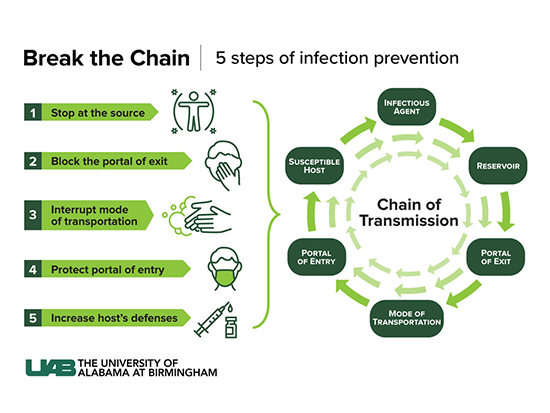Media contact: Hannah Echols
 A major lesson from the COVID-19 pandemic is understanding the basics of infection prevention measures before it is a matter of life or death. With increasing development worldwide and interactions between humans and animals, COVID-19, unfortunately, is not likely to be the last serious disease epidemic outbreak the world encounters.
A major lesson from the COVID-19 pandemic is understanding the basics of infection prevention measures before it is a matter of life or death. With increasing development worldwide and interactions between humans and animals, COVID-19, unfortunately, is not likely to be the last serious disease epidemic outbreak the world encounters.
“Of the deadliest disease outbreaks stretching back a century, more than half have occurred in the past two decades alone,” said Mary Duncan, R.N., senior director of Infection Prevention for the UAB Health System. “Infection prevention is any action a person can take to prevent a pathogen from entering the body and causing disease.”
Duncan, with 18 years of experience implementing best practices at various health facilities, noticed how confused her family and friends were when the pandemic began. She notes how quickly they lost faith in the people they thought they could trust, such as the government, the CDC, the World Health Organization and even their doctors.
“When people are in the middle of a crisis, they are not really open to learning new things, and fall back on what they know or what they think they know,” Duncan said. “It is very difficult to try to trust a new person when you are just trying to survive. The good news is that infection prevention actions are something that anyone can learn.”
Understand the chain of transmission
The best place to start, Duncan says, is with a model known as the chain of transmission.
Infections start with an infectious agent, or pathogens that can produce infection or disease. The infectious agent normally lives, grows and multiplies in a reservoir. This might be the environment, an insect or on a surface. With COVID-19 and flu, humans are the main reservoir.
To infect someone new, infections need a portal of exit from their reservoir. For COVID-19 and flu that is the respiratory tract. The agent then needs a mode of transmission to infect further hosts. The mode of transmission for both infections is illustrated when a person coughs, sneezes, talks or sings. The mode of transmission is mainly through direct contact with those droplets, or to some extent some aerosolized particles.
Infecting another person requires a portal of entry, which for COVID-19 and flu is the eyes, nose and mouth of the new host. Even once the infectious agent makes it inside another person, that person must be a susceptible host.
“Unfortunately, the susceptible host with COVID-19 and flu is really any person of any age, although older adults and those with preexisting medical conditions are more vulnerable to becoming severely ill,” Duncan said.
 Graphic: Jody PotterBreak the chain
Graphic: Jody PotterBreak the chain
To prevent the transmission of a pathogen, Duncan and infection prevention experts follow a tried-and-true playbook.
1) Stop it at the source
- Eliminate the infectious agent or source. This can be done by giving an antimicrobial to a patient who has an active infection or treating a wound infection so that no bacteria can go out into the environment.
- Quarantine exposed individuals during the incubation period, so there is no place for a person to spread the infectious agent.
- Isolate symptomatic persons so no new hosts become infected.
- Eliminate the reservoir by using approved disinfectant to clean surfaces or the pieces of equipment that the pathogen may be living on.
- Testing and surveillance can identify where the reservoirs are if a disease has asymptomatic spreaders, like COVID-19.
2) Interrupt the portal of exit
“If we haven’t been able to prevent infection in the reservoir, then we need to move to the next link in the chain and interrupt the portal of exit,” Duncan said.
Respiratory hygiene and cough etiquette, such as coughing into an elbow or tissue, can interrupt the mode of transmission. Masks prevent droplets from being dispersed into the environment and have been found effective in reducing COVID-19 and flu transmission, Duncan says.
For infections that are passed on in body fluid or feces, keep wounds clean and covered.
3) Interrupt the mode of transmission
“If we haven’t been successful yet, then we need to interrupt the mode of transmission,” Duncan said.
Taking standard precautions such as proper hand hygiene, use of gloves, safe injection practices, sterilizing instruments and cleaning environmental surfaces are an essential practice to prevent the spread of disease.
Watch Duncan’s full infection prevention seminar hosted by the Alabama Regional Center for Infection Prevention and Control here.
For highly infectious agents, such as flu and COVID-19, transmission-based precautions like wearing a mask or eye protection when in proximity can help prevent droplets from being spread or reaching a portal of entry.
“Over the past several years, we have learned how important it is to ensure that pathogens are not spread by the air,” Duncan said. “Having adequate ventilation where pathogens are being removed by effective filters or there is enough fresh air coming in to dilute the virus is an additional way reduce the mode of transmission.”
4) Protect the portal of entry
“If the pathogen does find a mode of transmission, there are several things we can do to block entry into our bodies,” Duncan said.
Masks and eye protection protect the most common access routes. Clean and cover any open wounds or breaks in the skin to add additional protection.
5) Increase the host’s defenses
If all efforts to break the chain fail and the pathogen makes it into the new host, the next step is stopping the pathogen from causing an infection. The No. 1 way to protect people from a potential pathogen is through the administration of an effective vaccine.
“Vaccines have essentially eliminated childhood illnesses that killed or maimed so many children in the past.” Duncan said. “I’m really one of the first generations who doesn’t know anybody who has had measles, mumps or polio. And my children’s generation is one of the first ones that won’t know anybody who has had chickenpox.”
The discovery of antibiotics has revolutionized the fight against pathogens. Duncan notes antibiotics should be used carefully due to pathogens’ ability to evolve and evade the treatment.
Creating good health habits and keeping up with personal hygiene are two additional ways hosts can strengthen their defenses.
“An individual’s health is so important in protecting them from pathogens,” Duncan said. “Studies have shown that people who smoke or have uncontrolled diabetes or are obese have worse outcomes if they are infected with COVID-19 or the flu.”
“Removing pathogens from our hands and skin with soap is so important, and then making sure that we have good oral hygiene as well. Both will prevent reservoirs on our body for the pathogens to live.”
Read more about infection prevention tips here.